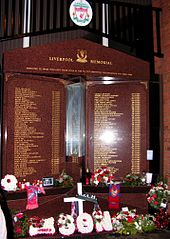
The Liverpool team at the start of the 1892–93 season, in which they won the Lancashire League
Soon after losing 2–1 to non-league Worcester City FC in the 1958–59 FA Cup, Bill Shankly was appointed manager and released 24 players. He converted a room at Anfield used for boot storage into a room where the coaches could talk strategy; here, Shankly and other "Boot Room" members Joe Fagan, Reuben Bennett, and Bob Paisley began reshaping the team. The club was promoted to the First Division in 1962, which it won for the first time in 17 years in 1964. The following year, the club won its first FA Cup, before winning the First Division again in 1966. Liverpool won the league and UEFA Cup double during the 1972–73 season and the FA Cup again a year later; soon afterwards, Shankly retired and was replaced by his assistant Bob Paisley. Under Paisley, the club won another league and UEFA Cup double 1976, just his second season as manager. The following season the club retained the league title, won the European Cup for the first time, but lost in the FA Cup final. Liverpool retained the European Cup the following season, before regaining the First Division title in 1979. During the nine seasons in which Paisley was manager, Liverpool won 21 trophies, including three European Cups, a UEFA Cup, six league titles and three consecutive League Cups; the only domestic trophy to elude him was the FA Cup.
Paisley retired in 1983 and was replaced by his assistant Joe Fagan. Liverpool won the League, League Cup and European Cup in Fagan's first season, becoming the first English side to win three trophies in a season. Liverpool reached the European Cup final again in 1985, against Juventus at the Heysel Stadium. Before kick-off, Liverpool fans breached a fence which separated the two groups of supporters and charged the Juventus fans. The resulting weight of people caused a retaining wall to collapse, killing 39 fans, who were mostly Italians. The incident became known as the Heysel Stadium Disaster, the match was played regardless, Liverpool lost 1–0 to Juventus. English clubs were consequently banned from participating in European competition for five years; Liverpool received a ten-year ban, which was later reduced to six years. Fourteen Liverpool fans received convictions for involuntary manslaughter.

Hillsborough memorial, which is engraved with the 96 people who died in the Hillsborough disaster
Liverpool was involved in the closest finish to a league season during the 1989–90, the club lost the title on goals scored and in the last minute of the season in a home defeat to eventual winners Arsenal. Dalglish cited the Hillsborough Disaster and its repercussions as the reason for his resignation in 1991. He was replaced by former player Graeme Souness, an FA Cup in 1992 was Souness' only trophy and he was replaced by Roy Evans. Liverpool won the League Cup in 1995 and a 4–3 victory over Newcastle United at Anfield on 3 April 1996, which was named in April 2003 as the Match of the Decade in the Premier League 10 Seasons Awards.
Gérard Houllier was appointed as co-manager in the 1998–99 season, he became the sole manager in November 1998 after Evans resigned. In 2001 Houllier's second full season in charge, Liverpool won a treble of the FA Cup, League Cup and UEFA Cup. Houllier underwent major heart surgery in the 2001–02 season and Liverpool finished second behind Arsenal. Houllier was replaced by Rafael Benítez at the end of the 2003–04 season. Despite finishing fifth in Benitez's first season, Liverpool won the UEFA Champions League beating Milan 3–2 in a penalty shootout after the match finished 3–3. The following season Liverpool finished third and won the 2006 FA Cup Final beating West Ham United in a penalty shootout after the match finished 3–3.
American businessmen George Gillett and Tom Hicks became the owners of Liverpool during the 2006–07 season in a deal which valued the club and its outstanding debts at £218.9 million. The club reached the 2007 UEFA Champions League Final against Milan in a repeat of the 2005 final, this time however, they lost 2–1. In the 2008–09 season Liverpool achieved 86 points, their highest Premier League points total, and finished as runners up to Manchester United. The following season the club finished seventh and failed to qualify for the Champions League. Benitez subsequently left by mutual consent and was replaced by Fulham manager Roy Hodgson. In 2010, the club were on the verge of bankruptcy with the club's creditors asking the High Court to allow for the sale of the club.
In October 2010, Boston Red Sox owner John W. Henry of New England Sports Ventures successfully bid and took ownership of Liverpool. In January 2011, former manager Kenny Dalglish was asked to take charge of the club until the end of the season after Roy Hodgson agreed to leave the club by mutual consent.


0 comments:
Post a Comment